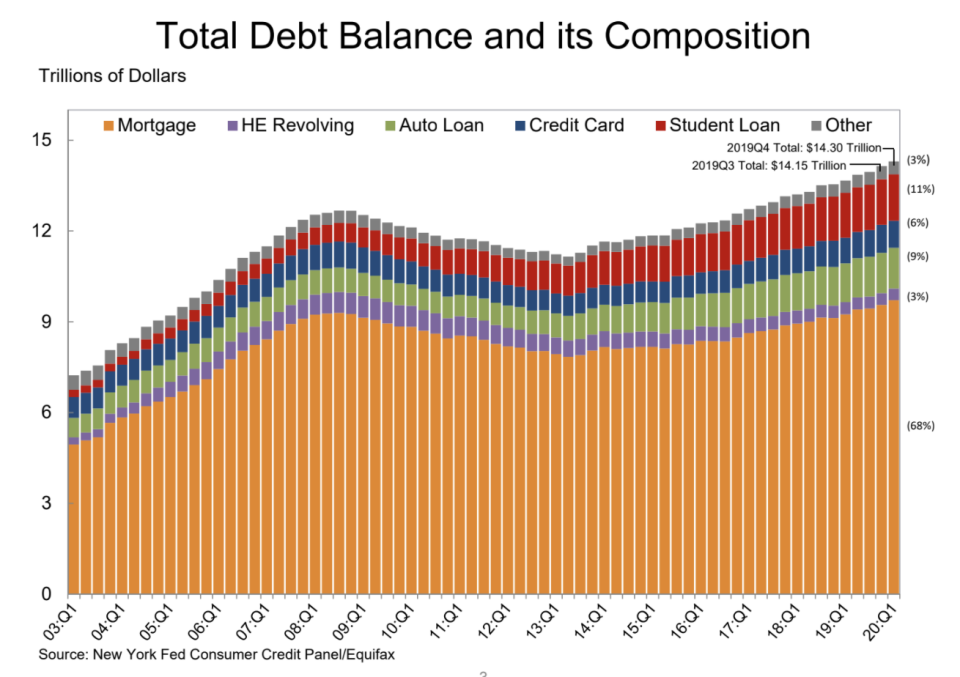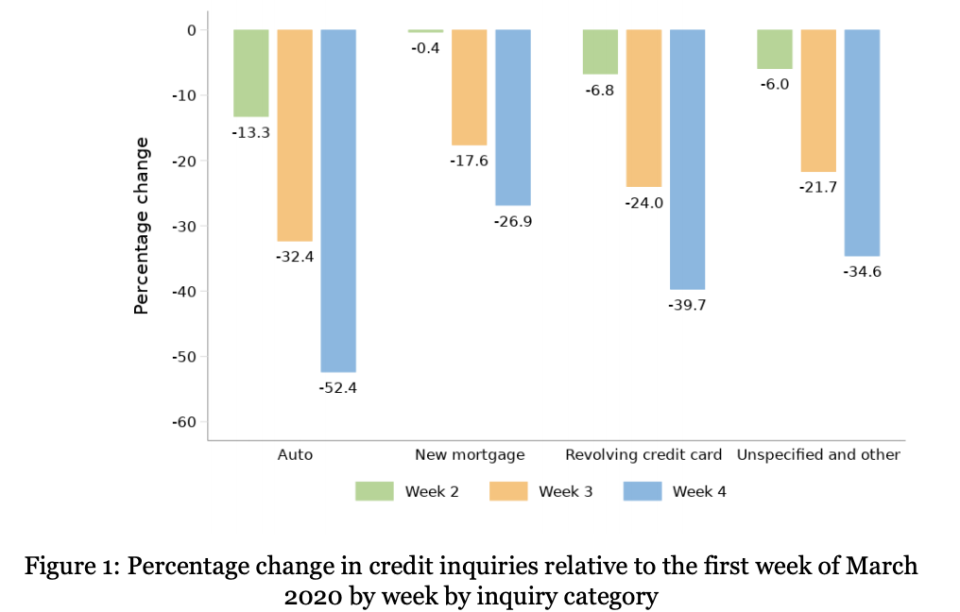U.S. household debt hit record high before unemployment spiked
Total U.S. household debt reached a record $14.3 trillion after increasing by $155 billion, or 1.1%, in the first quarter of 2020, according to the Fed’s Quarterly Report on Household Debt and Credit.
The results do not fully capture the economic pain felt from the coronavirus pandemic and widespread societal shutdown: The report noted that “the data do not fully reflect the potential effects of COVID-19 that materialized in the second half of March 2020.” More than 30 million Americans filed unemployment claims between the second half of March and April.
The report, based on “a nationally representative sample of individual- and household-level debt and credit records drawn from anonymized Equifax credit data,” found that the total household debt is now nominally $1.6 trillion higher than the pre-recession peak of $12.68 trillion in the third quarter of 2008.
Read more: How to manage debt: The full breakdown

COVID-19 impact yet to be felt in Q1
Housing balances increased considerably, rising by $156 billion in the first quarter, to $9.71 trillion. At the same time, foreclosures were at a low: About 75,000 individuals saw a new foreclosure notation on their credit reports between January 1 and March 31, “remaining low by historical standards.”
Non-housing balances were relatively flat overall.
Auto loans increased by $15 billion to total $1.35 trillion. Student loans increased by $27 billion for a total of $1.54 trillion in the first quarter. About 10.8% of those loans were in serious delinquency or default in the first quarter, which was a small decline from 11.1% in the previous quarter.
The rise in both auto and student loan increases were largely offset by the decline in credit card balances and other forms of debt — a $39 billion drop.

“It is critical to note that the latest report reflects a time when many of the economic effects of the COVID-19 pandemic were only starting to be felt,” Andrew Haughwout, senior vice president at the New York Fed, said in a press release. “We will continue to monitor these developments and the broader state of household balance sheets closely as key data are updated and the economic situation evolves.”
The Labor Department is expected to release April’s jobs report on Friday, and economists expect the U.S. to have lost 21.3 million jobs in April, forecasting the unemployment rate to jump from 4.4% to 16%.

A recent report by the Consumer Financial Protection Bureau, published May 1, offered some clues as to what to expect during the recovery: Between the first and last week of March, auto loan inquiries had dropped by 52%, new mortgage enquiries dropped by 27%, and revolving credit card inequities dropped by 40%.
Looking into geographical variations, the CFPB also found that states with more cases experienced larger drops in auto loan and mortgage inquiries — such as in the Northeast and in California.

CARES Act and forbearance options
Due to the Coronavirus Aid, Relief, and Economic Security (CARES) Act, mortgage and student loan payments were allowed to be put into penalty-free forbearance.
But the NY Fed estimates that only affects about 45% of the population aged 65 and below. So “while these policies certainly provide substantial benefits to mortgage and student loan borrowers, they do not benefit all consumers.”
Nevertheless, the NY Fed authors estimate the relief from these forbearance programs to be more than $370 billion of “temporary relief in cash flow to borrowers through deferred payments,” which is around the same size of the $349 billion first round of the Paycheck Protection Program.
The report also noted that about 189,000 consumers had a bankruptcy notation added to their credit reports in the first quarter, which was a decline from 192,000 in the first quarter of 2019.
— Brian Cheung contributed to this story
Aarthi is a reporter covering consumer finance and higher education for Yahoo Finance. She can be reached at [email protected]. Follow her on Twitter @aarthiswami.
Read more:
Read more personal finance information, news, and tips on Cashay
Follow Yahoo Finance on Twitter, Facebook, Instagram, Flipboard, SmartNews, LinkedIn, YouTube, and reddit.
